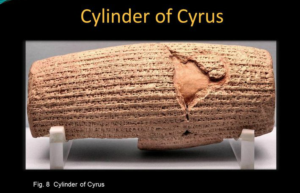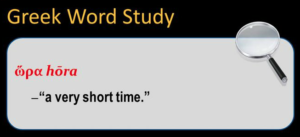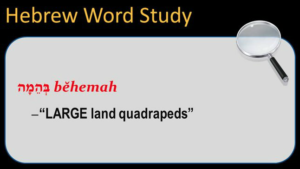Is Salvation Simply an “Admit One” Ticket to Heaven?
“You make choices, and you live with them.” Phil “Groundhog Day”
We have always had the freedom of choice, but no one has ever had the freedom to choose the results or consequences of those choices. Life, unfortunately, or maybe fortunately, does not work like Groundhog Day. We do not have the ability (or the opportunity) to go back in time and make a different choice, no matter how much we wish it were possible.
Salvation isn’t simply an “Admit One” ticket to Heaven that you can lose or give back, it is a free-will choice with eternal consequences. “Consequence” means a result or effect of an action or condition. This word usually has a negative connotation. But in general, it simply means what results from a particular choice or action.
How many choices in your life do you regret and wish you could go back and change. Or, are there choices that you are happy with? Maybe a choice that protected you from disaster? Good or bad, these are all irrevocable choices and the results of these choices cannot be undone.
Adam and Eve were faced with a choice—to eat of the fruit of the tree of knowledge of good and evil, or to obey God and not eat of it. They made an irrevocable choice, and of their own free will they chose to eat of the fruit.
They had been warned of the consequences — that they would surely die. Several things occurred because of their choice. They died immediately spiritually and began dying physically. To the woman God said, “I will greatly multiply thy sorrow and thy conception; in sorrow thou shalt bring forth children; and thy desire shall be to thy husband, and he shall rule over thee.”
To the man God said, “cursed is the ground for thy sake; in sorrow shalt thou eat of it all the days of thy life; Thorns also and thistles shall it bring forth to thee; and thou shalt eat the herb of the field; In the sweat of thy face shalt thou eat bread, till thou return unto the ground; for out of it wast thou taken: for dust thou art, and unto dust shalt thou return.”
Additionally, the entire creation became corrupted and is waiting to be regenerated, as Paul indicates in Romans 8:9-22 “For the eagerly awaiting creation waits for the revealing of the sons and daughters of God. For the creation was subjected to futility, not willingly, but because of Him who subjected it, in hope that the creation itself also will be set free from its slavery to corruption into the freedom of the glory of the children of God. For we know that the whole creation groans and suffers the pains of childbirth together until now.”
There was nothing Adam and Eve could do to reverse the consequences of their free-will choice. They could not go back in time and make a different choice, and they could not change the consequences of their choice.
A similar situation occurs when you are presented with the Salvation Gospel. You can make a choice to receive the free gift of Salvation, or you can choose to reject it. You can reject it over and over again, but at some point, you will reject it for the last time and will reap the consequences of that choice, and you will not be able to go back in time and make a different choice.
However, you can instead, of your own free will, make the choice to receive the free gift of Salvation, but just like Adam and Eve’s choice, it cannot be undone, because there are certain things that occur when you accept the free gift of Salvation. These results are all accomplished by God. We cannot do any of this ourselves and we also cannot undo anything that God does. As Paul says in Romans 11:29 — “The gifts and calling of God are irrevocable.”
The following things occur the moment we believe and put our trust in the finished work of Jesus Christ:
We are Born Again [John 3:1-9;]: We are born again by the Spirit. We are “being born again, not of corruptible seed, but of incorruptible, by the word of God, which liveth and abideth for ever.” [1 Peter 1:3,23] Incorruptible means “unperishable.” When we are born again we cannot perish, because we are born of incorruptible/unperishable seed.
Being born cannot be reversed, you can’t go back in time and prevent yourself from being born. Just as there is nothing you can do can change the fact that you were born from your biological parents, there is nothing you can do to change the fact that you were born again spiritually and have become a child of God [John 1:12-13].
We are a New Creation [2 Cor. 5:17; Gal. 6:15]: When we are born again, we are a new creation. A new creation cannot become “uncreated.” A new creation is something that never before existed, so you cannot become uncreated. For that to occur, you would have to go back in time and change it. There isn’t anything in the entire creation of God that can become uncreated.
We are “In Christ” [1 Cor. 12:13; Rom. 8:1; Rom. 16:7; 1 Cor. 1:30; 2 Cor. 5:17] : We are baptized [placed] into and become part of the body of Christ which is the Church, and we who have accepted the free gift of Salvation are described by Paul as being “in Christ.”
The Holy Spirit Indwells Us [John 14:16-18; 1 Cor. 6:19; 2 Tim. 1:14; ]: The Holy Spirit indwells us permanently. God promised that the Holy Spirit will never leave us. When we got saved, did we put the Holy Spirit in us? No, God did that. To become “unsaved,” the Holy Spirit would need to leave us. We cannot remove the Holy Spirit any more than we could put Him there in the first place.
We are Sealed by the Holy Spirit [Ephesians 1:13-14; Ephesians 4:30]: We are Sealed by the Holy Spirit UNTIL the redemption of our physical body. The fact of being sealed cannot end before the redemption, it can only be fulfilled by the redemption. “Until” doesn’t leave a gap where something else can occur in-between the two events. You cannot become unsealed. God sealed us through His Holy Spirit and we cannot reverse what God does.
We now Posses Eternal Life [John 3:36; John 5:24; John 6:47]: We have passed from death unto life. We possess Eternal Life now. You cannot lose Eternal Life, because if you did, it wasn’t Eternal Life, it was only life for a period of time. Eternal Life is a gift of God. And the gifts and calling of God are IRREVOCABLE! [Romans 11:29]. If we didn’t receive Eternal Life until after we have physically died. Then there would be a possibility, because it would be a future gift, but Jesus makes it very clear that we have already passed from death unto life.
We have been Redeemed [Acts 20:27-28, Galatians 4:4-5, Ephesians 7:7, Hebrews 9:12]
Jesus purchased us with his blood. We cannot change that. We permanently belong to Him. As Hebrews 9:12 states, “Neither by the blood of goats and calves, but by his own blood he entered in once into the holy place, having obtained eternal redemption for us.”
We have been “Declared Righteous”—A Judicial Position [Romans 5:9]: We are Justified — “Declared Righteous.” This is NOT affected by the sins or any actions of our past, or the sins or any actions that we will do in the future. Nor is it affected by the good things we do. It is a judicial position. We have been declared Righteous by God, we cannot change this. It is not based on what we did, or what we do or don’t do, it is ONLY based on what Jesus did. He paid the price of Salvation and gives it freely to all who believe/receive Him.
Being saved is not just being given a “Get out of Hell free card” or a free ticket to Heaven that says “Admit One” that you can loose or give back. There are unchangeable consequences/results of your free will choice to believe and trust in Jesus’ finished work of paying for all the sins of the world which is irrevocable and you cannot go back in time to reverse it. You cannot lose or even give back the free gift of Salvation.









